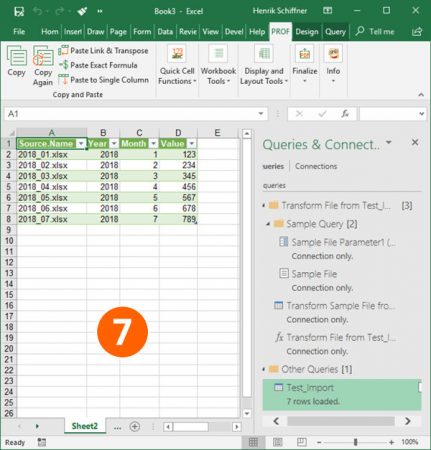5 Ways to Merge Excel Sheets Into One

Merging multiple Excel spreadsheets into a single cohesive file can seem like a daunting task. Whether you're consolidating financial reports, tracking inventory from different sources, or combining data for analysis, having all your information in one place can streamline processes significantly. Here's how you can accomplish this task with various methods, ensuring efficiency and accuracy.
Using Excel’s Built-In Tools

Excel comes with several built-in features that allow you to merge sheets:
- Consolidate: Navigate to the 'Data' tab and select 'Consolidate'. This tool allows you to merge data from multiple ranges into a single sheet. You can choose functions like Sum, Count, Average, etc., to aggregate data.
- VLOOKUP or HLOOKUP: If your spreadsheets contain unique identifiers, you can use these functions to pull data from one sheet to another based on these keys.
- Power Query: For more advanced users, Power Query offers robust data transformation capabilities. You can append or merge queries to combine data from multiple sources.

⚠️ Note: Ensure that the data in each sheet follows the same structure for a seamless consolidation using Power Query.
Using VBA Macros

For those who are comfortable with coding, VBA (Visual Basic for Applications) can automate the merging process:
- Create a macro that loops through workbooks, opening each file, copying the desired data, and pasting it into a master sheet in a pre-specified workbook.
Sub MergeWorkbooks()
Dim wbDestination As Workbook
Dim wbSource As Workbook
Dim wsDestination As Worksheet
Dim wsSource As Worksheet
Dim FilePath As String
Dim FileName As String
Set wbDestination = ThisWorkbook
Set wsDestination = wbDestination.Sheets("Master")
'Set the folder path where your workbooks are located
FilePath = "C:\Path\To\Your\Folder\"
FileName = Dir(FilePath & "*.xlsx")
Do While FileName <> ""
Set wbSource = Workbooks.Open(FilePath & FileName)
For Each wsSource In wbSource.Worksheets
If wsSource.Name <> "Sheet1" Then 'assuming the sheets you want to merge are not named "Sheet1"
wsSource.Cells.Copy Destination:=wsDestination.Cells(wsDestination.Rows.Count, 1).End(xlUp).Offset(1, 0)
End If
Next wsSource
wbSource.Close False
FileName = Dir()
Loop
End Sub
Place this code in the VBA editor, set the file path, and run the macro to merge sheets automatically.
🧠 Note: Remember to adjust the file path in the macro according to where your Excel files are stored.
Using Third-Party Tools

There are several third-party applications available for those who prefer a GUI over coding or need more complex merging capabilities:
- Microsoft Power Automate: Formerly known as Flow, this tool can automate repetitive tasks like merging Excel files.
- EasyMerge: A simple tool for those who don't want to delve into VBA.
- Excel Compare: Primarily for comparing sheets, but it can be used to merge them as well.
Manual Copy and Paste Method

For those with fewer files or when the other methods seem overwhelming, manual copy-pasting remains an option:
- Open all workbooks involved.
- Copy the necessary ranges or entire sheets from each source workbook.
- Paste this data into your master sheet in the destination workbook.
💡 Note: This method is time-consuming and error-prone for large datasets or numerous files.
Using Online Platforms

Several online tools offer solutions for merging Excel sheets without having to download any software:
- Google Sheets Import Functions: You can import data from other spreadsheets using IMPORTRANGE, then combine data from various sheets.
- Online Merge Tools: Websites like MergeExcel.com or Excel-Online.com can merge spreadsheets uploaded by the user.
By exploring these methods, you can find the best way to manage and merge your data efficiently. Whether you opt for the automated approach of VBA, the simplicity of Excel's built-in tools, or the convenience of online platforms, there's a method suited for every scenario.
Here are some essential tips to keep in mind when merging sheets:
- Verify the Data: Ensure data integrity before and after merging to avoid errors or data loss.
- Backup Files: Always save copies of your original files before merging.
- Organize Sheets: Label and format your sheets consistently to simplify the merging process.
In summary, merging Excel sheets doesn't have to be a headache. With the right tools and techniques, from Excel's in-built features to custom scripts and online tools, you can streamline your data management tasks. Be it consolidating reports, preparing for analysis, or simply organizing data, there's a solution for every user's needs.
Can I merge Excel sheets if they have different structures?

+
Yes, but you might need to use more sophisticated tools like Power Query or VBA macros to handle the differences in data structure effectively. Manual adjustments might also be required to align the data properly.
How can I merge Excel files automatically without VBA?

+
You can use Microsoft Power Automate or Google Sheets’ IMPORTRANGE function, which can automate data merging without coding. Third-party tools like EasyMerge also provide a user-friendly interface for merging without scripting.
What should I do if I face errors when merging data?

+
First, check for data format inconsistencies, mismatched ranges, or errors in formulas. If using VBA, ensure the macro is properly configured. Backup your data before merging, and if problems persist, consider manual methods or seek help from a professional.